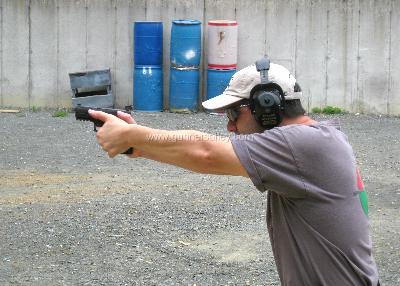Here’s an interesting article from The Daily Caller (https://dailycaller.com/) regarding the importance of practicing the draw from concealed carry versus doing most of your shooting from the low ready. I’ve republished here in it’s entirety and included a link back to the original source if you like to read it there. Below the article, I’ve included some thoughts on the content along with suggestions to get around some common issues with practicing from the concealed carry position.
 “An easily overlooked skill when it comes to concealed carry and/or armed self-defense is the draw, the act of getting the gun into the fight. So much is made of the act of shooting that a person could easily overlook it.
“An easily overlooked skill when it comes to concealed carry and/or armed self-defense is the draw, the act of getting the gun into the fight. So much is made of the act of shooting that a person could easily overlook it.
That could be a serious folly.
The draw is arguably the most important aspect. Whether you use a Weaver, Isosceles or Chapman stance (or for that matter shoot one-handed) doesn’t really matter all that much outside of the range. Granted, if you’re a competitive shooter then okay, but outside of that, it comes close to ephemera.
Trigger pull isn’t. You need to have that down, so make sure you aren’t skipping your dry firing.
However, drawing from your concealed carry holster or other carrying implement is definitely a skill that should be practiced and kept up. It might just make a crucial difference if you ever have to use your pistol in defense of yourself and/or others.
For starters, odds are that if you ever had to draw your gun in self-defense, that’s actually all you’ll have to do. The studies that are available on defensive gun use vary wildly in terms of the number of them per year (ask the NRA, it’s a few million per year; other sources, like this paper from the Violence Policy Center, it’s fewer than 100,000 per year) and so on, but a general principle that most agree upon it’s that most defensive gun usage consists of no more than drawing the gun or making it visible to a credible threat.
Granted, these studies rely on data that’s reported to federal agencies. Not all state or local law enforcement agencies do so (reporting to the BJS or FBI is largely voluntary) and then you also have incidents that are never reported. As a result, it’s impossible to tell exactly how many defensive gun uses actually occur, but reading a few papers will give you some good general ideas.
One takeaway? Most DGUs only involve drawing the gun. Far fewer involve actually shooting the person making the threat, and very, very few result in the death of a criminal. Therefore, if drawing the gun is all you’re likely to ever do, it behooves you to do so well.
Then there’s the issue of firing if you were called upon to do so.
The sooner you can get your gun into the fight and on target the better, as the faster you’ll be able to deliver a bullet. The first hit doesn’t often win a fight; as the first accurate hit to a vital area will likely have a greater effect.
Some of the gunfighters of past eras put more emphasis on the draw than almost any other aspect of gun use. Delf “Jelly” Bryce, a famous Kansas City lawman who eventually became a hostage negotiator for the FBI, was known to practice drawing from his holster daily, sometimes for hours at a time. It also made him lightning-fast; Bryce was timed on a number of occasions to see how fast he could draw, fire and hit a target. He was clocked at .27 seconds.
Bill Jordan wrote in his book “No Second Place Winner” that 90 percent of a peace officer’s firearms practice should be drawing and firing a single shot, often called the “first shot drill.” As he put it, “if the first one’s in, the rest are sure to follow.” Jordan was also a quick-draw shooter of incredible skill; he posted a best time of .28 seconds.
Both put these skills to actual use.
So, you’re more likely to only pull your pistol in defense of yourself. If you must shoot, it’s best to get on target in the shortest possible time. How best to be able to do so? Practice the draw.”
Source: https://dailycaller.com/2017/12/16/ccw-weekend-draw/
I fully agree with everything mentioned in the article, but wanted to expand on a few points:
#1 – Restrictive range rules: Some ranges have restrictive rules that will not allow a shooter to draw and shoot from a holster. Some require that you only shoot from the low ready position. So how do you get around this issue? One possibility would be to find a more relaxed range. If that’s not an option, you’ll have to practice with an unloaded weapon and dry fire using snap caps.
#2 – Accuracy over speed: Everybody likes speed, but it’s useless if you can’t hit the target. Instead of focusing on speed in the beginning, start by focusing on the accuracy part of the equation. Improvements in speed will come with the repetitive motion of practice.
#3 – Have realistic expectations: When you start practicing the draw, people tend to get caught up in the speed aspect, and are disappointed that they can’t draw and fire like Jerry Miculiek. You’ll be much less disappointed and more likely to stick with regular practice if you start with realistic expectations.
